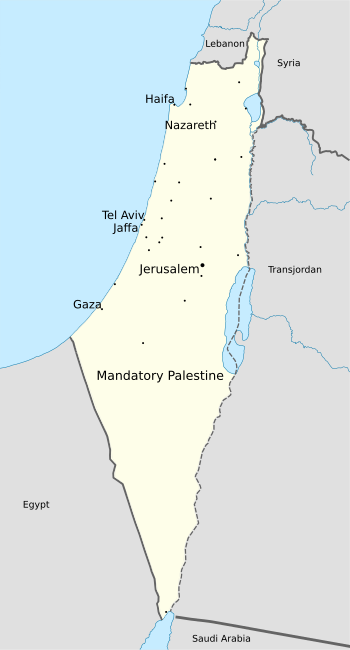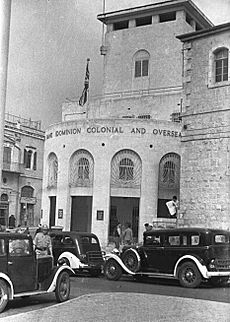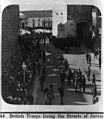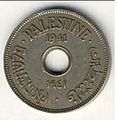Mandatory Palestine facts for kids
Quick facts for kids
Palestine
|
|||||||||||||
|---|---|---|---|---|---|---|---|---|---|---|---|---|---|
| 1920–1948 | |||||||||||||
|
|
|||||||||||||

Mandatory Palestine in 1946
|
|||||||||||||
| Status | Mandate of the United Kingdom | ||||||||||||
| Capital | Jerusalem | ||||||||||||
| Common languages | English, Arabic, Hebrew | ||||||||||||
| Religion | Islam, Judaism, Christianity, Baháʼí Faith, Druze faith | ||||||||||||
| High Commissioner | |||||||||||||
|
• 1920–1925 (first)
|
Sir Herbert L. Samuel | ||||||||||||
|
• 1945–1948 (last)
|
Sir Alan Cunningham | ||||||||||||
| Legislature | |||||||||||||
|
• Parliamentary body of the Muslim Community
|
Supreme Muslim Council | ||||||||||||
|
• Parliamentary body of the Jewish Community
|
Assembly of Representatives | ||||||||||||
| Historical era | Interwar period, World War II, Cold War | ||||||||||||
|
• Mandate assigned
|
25 April 1920 | ||||||||||||
|
• Britain officially assumes control
|
29 September 1923 | ||||||||||||
| 14 May 1948 | |||||||||||||
| Area | |||||||||||||
|
• Total
|
25,585.3 km2 (9,878.5 sq mi) | ||||||||||||
| Currency | Egyptian pound (until 1927) Palestine pound (from 1927) |
||||||||||||
| ISO 3166 code | PS | ||||||||||||
|
|||||||||||||
| Today part of | Israel Palestine |
||||||||||||
Mandatory Palestine (Arabic: فلسطين الانتدابية Filasṭīn al-Intidābiyah; Hebrew: פָּלֶשְׂתִּינָה (א״י) Pāleśtīnā (E.Y.), where "E.Y." indicates ’Eretz Yiśrā’ēl, the Land of Israel) was a geopolitical entity established between 1920 and 1948 in the region of Palestine under the terms of the League of Nations Mandate for Palestine.
During the First World War (1914–1918), an Arab uprising against Ottoman rule and the British Empire's Egyptian Expeditionary Force under General Edmund Allenby drove the Ottoman Turks out of the Levant during the Sinai and Palestine Campaign. The United Kingdom had agreed in the McMahon–Hussein Correspondence that it would honour Arab independence if the Arabs revolted against the Ottoman Turks, but in the end, the United Kingdom and France divided the area under the Sykes–Picot Agreement — an act of betrayal in the eyes of the Arabs.
Further complicating the issue was the Balfour Declaration of 1917, promising British support for a Jewish "national home" in Palestine. At the war's end the British and French formed a joint "Occupied Enemy Territory Administration" in what had been Ottoman Syria. The British achieved legitimacy by obtaining a mandate from the League of Nations in June 1922. One objective of the League of Nations mandate system was to administer areas of the defunct Ottoman Empire "until such time as they are able to stand alone".
During the Mandate, the area saw the rise of nationalist movements in both the Jewish and Arab communities. Competing interests of the two populations led to the 1936–1939 Arab revolt in Palestine and the 1944–1948 Jewish insurgency in Mandatory Palestine. The United Nations Partition Plan for Palestine, passed in November 1947, was met with Arab rejection. The 1947–1949 Palestine war ended with the territory of Mandatory Palestine divided among the State of Israel, the Hashemite Kingdom of Jordan, which annexed territory on the West Bank of the Jordan River, and the Kingdom of Egypt, which established the "All-Palestine Protectorate" in the Gaza Strip.
Government and institutions

Under the terms of the August 1922 Palestine Order in Council, the Mandate territory was divided into administrative regions known as districts and administer by the office of the British High Commissioner for Palestine.
Britain continued the millet system of the Ottoman Empire whereby all matters of a religious nature and personal status were within the jurisdiction of Muslim courts and the courts of other recognised religions, called confessional communities. The High Commissioner established the Orthodox Rabbinate and retained a modified millet system which only recognised eleven religious communities: Muslims, Jews and nine Christian denominations (none of which were Christian Protestant churches). All those who were not members of these recognised communities were excluded from the millet arrangement. As a result, there was no possibility, for example, of marriages between confessional communities, and there were no civil marriages. Personal contacts between communities were nominal.
Apart from the Religious Courts, the judicial system was modelled on the British one, having a High Court with appellate jurisdiction and the power of review over the Central Court and the Central Criminal Court. The five consecutive Chief Justices were:
- Thomas Haycraft (1921–1927)
- Michael McDonnell (1927–1936)
- Harry Herbert Trusted (1936–1941) (afterwards Chief Justice of the Federated Malay States, 1941)
- Frederick Gordon-Smith (1941–1944)
- William James Fitzgerald (1944–1948)
Economy
Between 1922 and 1947, the annual growth rate of the Jewish sector of the economy was 13.2%, mainly due to immigration and foreign capital, while that of the Arab was 6.5%. Per capita, these figures were 4.8% and 3.6% respectively. By 1936, Jews earned 2.6 times as much as Arabs. Compared to Arabs in other countries, Palestinian Arabs earned slightly more.
The Jaffa Electric Company was founded in 1923 by Pinhas Rutenberg, and was later absorbed into a newly created Palestine Electric Corporation; the First Jordan Hydro-Electric Power House was opened in 1933. Palestine Airways was founded in 1934, Angel Bakeries in 1927, and the Tnuva dairy in 1926. Electric current mainly flowed to Jewish industry, following it to its nestled locations in Tel Aviv and Haifa. Although Tel Aviv had by far more workshops and factories, the demand for electric power for industry was roughly the same for both cities by the early 1930s.
The country's largest industrial zone was in Haifa, where many housing projects were built for employees.
On the scale of the UN Human Development Index determined for around 1939, of 36 countries, Palestinian Jews were placed 15th, Palestinian Arabs 30th, Egypt 33rd and Turkey 35th. The Jews in Palestine were mainly urban, 76.2% in 1942, while the Arabs were mainly rural, 68.3% in 1942. Overall, Khalidi concludes that Palestinian Arab society, while overmatched by the Yishuv, was as advanced as any other Arab society in the region and considerably more than several.
Education
Under the British Mandate, the country developed economically and culturally. In 1919 the Jewish community founded a centralised Hebrew school system, and the following year established the Assembly of Representatives, the Jewish National Council and the Histadrut labour federation. The Technion university was founded in 1924, and the Hebrew University of Jerusalem in 1925.
Literacy rates in 1932 were 86% for the Jews compared to 22% for the Palestinian Arabs, but Arab literacy rates steadily increased thereafter. By comparison, Palestinian Arab literacy rates were higher than those of Egypt and Turkey, but lower than in Lebanon.
Gallery
-
Field Marshal Allenby entering Jerusalem with British troops on 11 December 1917
-
General Watson meeting with the Mayor of Jerusalem in December 1917
-
The Western Wall, 1933
-
YMCA in Jerusalem, built during the British Mandate
-
"Bevingrad" in Jerusalem, Russian Compound behind barbed wire
See also
 In Spanish: Mandato británico de Palestina para niños
In Spanish: Mandato británico de Palestina para niños


















